
polinomi e scomposizione
- Subject:
- Information Science
- Material Type:
- Module
- Author:
- Maria Caterina Gatto
- Date Added:
- 06/01/2017


polinomi e scomposizione
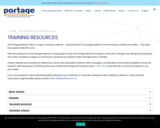
The Portage Network offers a range of training materials – everything from one-page guides to online training modules and videos – that span the research data life cycle.
With the assistance of the Portage National Training Expert Group, the Portage Network of Experts continues to develop new bilingual training aids and online modules to support a community of practice for research data management in Canada.
These materials are intended for researchers, library data specialists, research data managers, and discipline and functional experts across the research data landscape. All training resources created by Portage are licensed under CC BY-NC 4.0 and are free to share and adapt for your own needs.
If you have questions about developing RDM training at your institution or would like assistance with creating in-person or online training resources or opportunities, please contact RDM-GDR@alliancecan.ca.

Word Count: 3238
(Note: This resource's metadata has been created automatically by reformatting and/or combining the information that the author initially provided as part of a bulk import process.)

Poster - Silly Questions Forum - 2023 MLA Annual Meeting Detroit
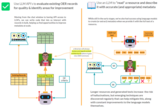
With over 305,000 open educational resources cataloged on OER Commons since 2007, ISKME works to make learning and knowledge sharing more participatory, equitable, and open, in pursuit of a more just society.
Those resources don’t describe themselves, though. The metadata of every resource in OER Commons was put together by someone before it got added to our collection, and then a librarian at ISKME reviewed it for quality – and that’s a lot of work, both in and out of house!
How much work? Well, if a librarian were to spend just five minutes on each record that ever found its way into our collection, that would take 25,433 hours. That’s enough time to…
- do 123 round trips to the moon (time to finally take that leave you’ve been saving)
- get 3,178 full nights of sleep (unless you’re a cat, then it’s only 1,413)
- walk 8 times from Cape Town to Copenhagen (we’re gonna need a bigger passport)
- work full-time for over 13 years (don’t worry, that excludes 4 weeks vacation)
All of that to say, metadata takes time.
It can be a challenge to balance metadata creation with other tasks like maintaining existing records, curation work, and supporting educational partners with curation. As such, we’re always on the lookout for tools and techniques that boost our capacity without compromising quality.
In 2023 and 2024, we’re testing out how generative AI tools like large language models can support our work in the OER landscape. This poster highlights some of the places where we’ve had successes, along with possible future applications that we think are both useful and doable.

This open course introduces students to the scholarly communications system — with particular emphasis on the scholarly journal publishing mechanism — wherein new information is created, evaluated, disseminated, and preserved.
The course content is organized into three parts. First, The Fundamentals aims to acquaint students with the basic framework of contemporary scholarly publishing: how it operates, who is involved, what roles they play, etc., as well as asking students to consider how they themselves might engage with the system as consumers and producers of scholarly knowledge. Chapters include sample exercises to reinforce content, as well as recommended resources for further study. Next, (Some) Problems raises questions and issues that complicate contemporary scholarly publishing. While scholarship and research have the noble goal of building and sharing new knowledge for the public good, they are also inextricably bound to real-world economic structures and inequalities. This section examines how the scholarly publishing system intersects with money, power, and privilege. It asks students to grapple with the system’s structural, systemic failings, as well as contemplate ways in which it might be improved. Finally, the course culminates in two final Assignments that instructors can use as part of the curriculum, or that independent learners can work through on their own. These are open-ended in that there are no discrete right or wrong answers, but rather opportunities for students to grapple with and reflect on the content of the course.
Material in this course can be used in classroom settings or as self-paced tutorial. Appropriate audiences include upper-level undergraduate or graduate students who are interested in publishing their work; library & information science (LIS) students or early-career librarians interested in scholarly communications; and anyone else who wants a better understanding of the scholarly publishing system and the academic culture in which it is rooted.
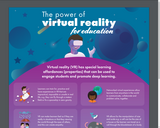
Infographic Virtual reality (VR) has special learning
affordances (properties) that can be used to
engage students and promote deep learning.

Short Description:
This open-access textbook is for those who want to write exemplary social research. It provides an extensive outline of each step of the research process: outlining practical tools for conceptualizing its beginnings, generating proposals, getting ethics approval, relaxing from the stresses of research, writing academically, conducting a literature review, drafting a methods section, collecting the right data, formulating the findings, and sharing the results. Woven throughout each chapter are testimonies of other students who have likewise persevered through the research process, relating their obstacles, solutions, and motivations to each stage of the research process to illuminate not only the technical goals of research, but also the emotional maturity that research entails.
Long Description:
This open-access textbook is for those who want to write exemplary social research. It provides an extensive outline of each step of the research process: outlining practical tools for conceptualizing its beginnings, generating proposals, getting ethics approval, relaxing from the stresses of research, writing academically, conducting a literature review, drafting a methods section, collecting the right data, formulating the findings, and sharing the results. Woven throughout each chapter are testimonies of other students who have likewise persevered through the research process, relating their obstacles, solutions, and motivations to each stage of the research process to illuminate not only the technical goals of research, but also the emotional maturity that research entails.
Word Count: 84578
ISBN: 978-0-88865-486-1
(Note: This resource's metadata has been created automatically by reformatting and/or combining the information that the author initially provided as part of a bulk import process.)

In this webinar Professor Brian Nosek, Executive Director of the Center for Open Science (https://cos.io), outlines the practice of Preregistration and how it can aid in increasing the rigor and reproducibility of research. The webinar is co-hosted by the Health Research Alliance, a collaborative member organization of nonprofit research funders. Slides available at: https://osf.io/9m6tx/

This guide focuses specifically on some of the decisions you may need to make regarding the materials you have created or used in your research process, including drawings and photographs, tables and charts, lab notes and datasets, interviews and newscasts, software and digital artworks. It describes in non-legal language the basics of a few important terms, including “fair use,” “public domain,” “Creative Commons,” and “patent” as they may apply to these materials. Failure to consider the implications of different copyright and patent approaches for your own work can limit the impact of your work. Failure to adequately review, vet, and seek permission to use others’ work can, in a worst-case scenario, prevent your work from getting published or (in rare cases) lead to legal actions.
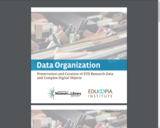
How researchers structure their data varies by disciplines and research questions. Still, there are general guidelines for structuring data that make it more likely to be usable in the future. The following questions should be considered for any project that gathers data. These questions should be considered first at the planning stage, again as data is being gathered and stored, and once more prior to final deposit into a digital archive or repository.
1. What are the data organization standards for your field? For example, there are often standards for labeling data fields that will make your data machinereadable. There may also be specific variables and coding guidelines that you can use that will make your work interoperable with other datasets. Lastly, there may be accepted hierarchies and directory structures in your discipline that you can build upon.
2. What are the data export options in the software you are using? If using proprietary and/or highly specialized software to analyze large data sets, export the data in a format that is likely to be supported in the future, and that will be accessible from other software programs. This usually means choosing an open format that is not proprietary. Remember that you may not have access to the same software in the future, and not all software upgrades can read old file types.
3. What forms of the data will be needed for future access? Consider the various forms the data may take, and the scale of the data involved. You may need to preserve not only the underlying raw data, but also the resulting analyses you have created from it.

Word Count: 2762
(Note: This resource's metadata has been created automatically by reformatting and/or combining the information that the author initially provided as part of a bulk import process.)

Students will distinguish between different types of sources, including primary and secondary resources, in order to select sources appropriate for their information need/assignment

This course surveys a variety of reasoning, optimization and decision making methodologies for creating highly autonomous systems and decision support aids. The focus is on principles, algorithms, and their application, taken from the disciplines of artificial intelligence and operations research.
Reasoning paradigms include logic and deduction, heuristic and constraint-based search, model-based reasoning, planning and execution, and machine learning. Optimization paradigms include linear programming, integer programming, and dynamic programming. Decision-making paradigms include decision theoretic planning, and Markov decision processes.

Short Description:
This collection features essays, case studies, and pedagogical approaches that explore how educators managed the privacy, security, and safety concerns that rushed into our lives as we shifted into emergency remote learning in 2020. While the COVID-19 pandemic brought this concern into focus, privacy issues with online learning continue to exist alongside us and our students. This book provides readers insight into the current state of privacy issues, describes the challenges and rewards of developing more privacy-focused learning environments, and presents several resources and tools that readers can bring to their own teaching practices.Representing a variety of perspectives from K-12, higher education, and libraries, contributors describe the challenges they encountered and offer solutions to help ensure the safekeeping of students’ online lives. How do we navigate these online environments, who collects our data, and how can we protect our most vulnerable populations?
Long Description:
This collection features essays, case studies, and pedagogical approaches that explore how educators managed the privacy, security, and safety concerns that rushed into our lives as we shifted into emergency remote learning in 2020. While the COVID-19 pandemic brought this concern into focus, privacy issues with online learning continue to exist alongside us and our students.
This book provides readers insight into the current state of privacy issues, describes the challenges and rewards of developing more privacy-focused learning environments, and presents several resources and tools that readers can bring to their own teaching practices.
Representing a variety of perspectives from K-12, higher education, and libraries, contributors describe the challenges they encountered and offer solutions to help ensure the safekeeping of students’ online lives. How do we navigate these online environments, who collects our data, and how can we protect our most vulnerable populations?
This platform is the Web book. For PDF and print copies, https://openpress.mtsu.edu/index.php/mtop/catalog/book/onlinelearning.
Word Count: 83213
ISBN: 979-8-9871721-0-0
(Note: This resource's metadata has been created automatically by reformatting and/or combining the information that the author initially provided as part of a bulk import process.)

How safe are your students online? This lesson includes resources with facts and tips about online privacy and security for students. Students will 1.) evaluate resources for best practices in cyber privacy and security and 2.) identify a goal to strengthen an area of cyber privacy and security in their online behavior. (Thumbnail image attribute: Alpha Stock Images http://alphastockimages.com/)

Segment 1 Professional DevelopmentSurvey MonkeyPowToonYouTubeKahoot

Professional learning opportunities and guidance resources for teacher librarians.
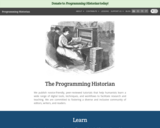
We publish novice-friendly, peer-reviewed tutorials that help humanists learn a wide range of digital tools, techniques, and workflows to facilitate research and teaching. We are committed to fostering a diverse and inclusive community of editors, writers, and readers.

The best way to learn how to program is to do something useful, so this introduction to MATLAB is built around a common scientific task: data analysis. Our real goal isn’t to teach you MATLAB, but to teach you the basic concepts that all programming depends on. We use MATLAB in our lessons because: we have to use something for examples; it’s well-documented; it has a large (and growing) user base among scientists in academia and industry; and it has a large library of packages available for performing diverse tasks. But the two most important things are to use whatever language your colleagues are using, so that you can share your work with them easily, and to use that language well.